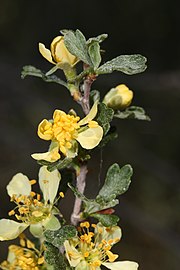Purshia tridentata
| Bitterbrush | |
|---|---|

| |
| Purshia tridentata, Wenas Wildlife Area | |
| Scientific classification | |
| Kingdom: | Plantae |
| Clade: | Tracheophytes |
| Clade: | Angiosperms |
| Clade: | Eudicots |
| Clade: | Rosids |
| Order: | Rosales |
| Family: | Rosaceae |
| Genus: | Purshia |
| Species: | P. tridentata
|
| Binomial name | |
| Purshia tridentata | |
| Synonyms[1] | |
| |
Purshia tridentata, with the common name bitterbrush,[1][2][3] is a shrub in the genus Purshia of the family Rosaceae. It is native to mountainous areas of western North America.[3]
Common names include antelope bitterbrush,[3][2] antelope bush,[2] buckbrush, quinine brush, and less commonly deerbrush, blackbrush, and greasewood.[4] Some of these names are shared with other species.
Description
[edit]Purshia tridentata is a deciduous shrub growing to a height of 1–5 metres (3+1⁄2–16+1⁄2 feet). It has many branches and slender green,[5] three- to five-lobed leaves 5–20 millimetres long. It is a nitrogen-fixing plant.[6]
The flowers are pale yellow,[5] with five petals 6–8 mm long, and darker yellow anthers. The fruit is a cluster of dry, slender, leathery achenes 0.6–2 centimetres long.
Varieties
[edit]There are two named varieties of the species:
- Purshia tridentata var. glandulosa — Eastern Sierra Nevada, Southern California[7]
- Purshia tridentata var. tridentata[8]
Distribution
[edit]The plant is found from southeastern British Columbia in the north, east to Montana and Wyoming, south to New Mexico, and west in California.[3] It grows on arid mountainsides and slopes, as well as rocky or drained soils with somewhat more moisture than the sagebrush steppe.[5] It is often associated with Balsamorhiza as well as Wyethia species, and in southern areas hybridizes with Purshia stansburyana.[5]
In California it occurs between 700–3,400 m (2,300–11,200 ft) above sea level, including in the Peninsular Ranges, Transverse Ranges, and Sierra Nevada, and southern Cascade Range.[2][9] Further north it occurs at lower elevations, such as at 320–1,065 m (1,050–3,494 ft) in British Columbia.[10]
Uses
[edit]The shrub is an important forage plant for many game animals, including deer,[5] especially during the winter.[11]
References
[edit]- ^ a b James Henrickson, "Purshia tridentata (Pursh) de Candolle, Trans. Linn. Soc. London. 12: 158. 1818", Flora of North America, vol. 9
- ^ a b c d CalFlora Database:Purshia tridentata . accessed 9.22.2013
- ^ a b c d NRCS. "Purshia tridentata". PLANTS Database. United States Department of Agriculture (USDA). Retrieved 16 October 2015.
- ^ United States Congressional serial set. U.S. Government Printing Office. 1861.
- ^ a b c d e Taylor, Ronald J. (1994) [1992]. Sagebrush Country: A Wildflower Sanctuary (rev. ed.). Missoula, MT: Mountain Press Pub. Co. p. 126. ISBN 0-87842-280-3. OCLC 25708726.
- ^ David Andrews Dalton (1975). Nitrogen fixation by Purshia tridentata: some ecological aspects and root nodule anatomy. Oregon State University. Retrieved 16 November 2011.
- ^ CalFlora Database: Purshia tridentata var. glandulosa
- ^ CalFlora Database: Purshia tridentata var. tridentata
- ^ Brian Vanden Heuvel & Thomas J. Rosatti 2016. Purshia tridentata, in Jepson Flora Project (eds.) Jepson eFlora, accessed 19 June 2016
- ^ E-FLORA BC: Electronic Atlas of the Flora of British Columbia
- ^ Whitney, Stephen (1985). Western Forests (The Audubon Society Nature Guides). New York: Knopf. p. 401. ISBN 0-394-73127-1.
External links
[edit]- Central Washington Native Plants: Antelope bitterbrush
- Range Plants of Utah: Purshia tridentata (Antelope bitterbrush)
 Media related to Purshia tridentata at Wikimedia Commons
Media related to Purshia tridentata at Wikimedia Commons
- Purshia
- Flora of the Northwestern United States
- Flora of the Southwestern United States
- Flora of British Columbia
- Flora of California
- Flora of New Mexico
- Flora of Wyoming
- Flora of the Cascade Range
- Flora of the Great Basin
- Flora of the Rocky Mountains
- Flora of the Sierra Nevada (United States)
- Natural history of the Peninsular Ranges
- Taxa named by Augustin Pyramus de Candolle


